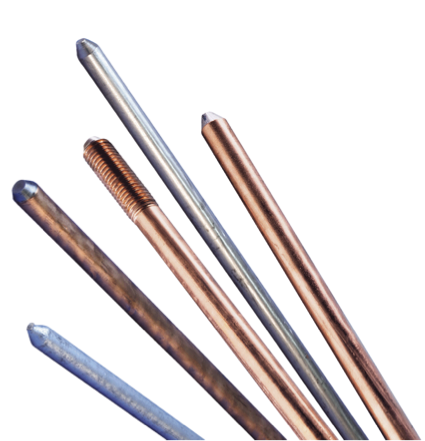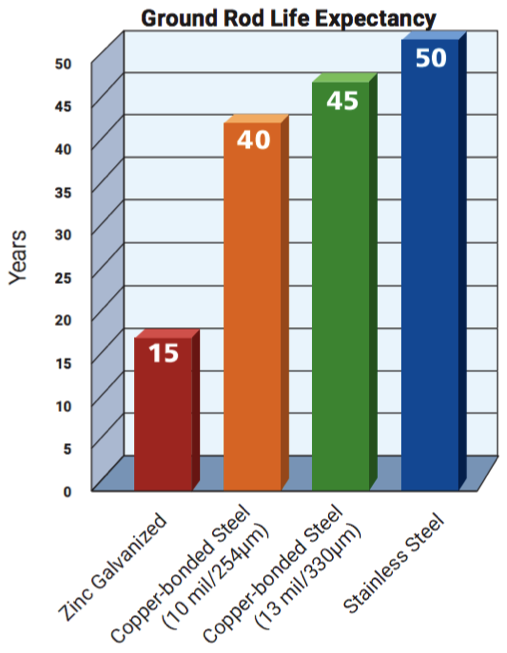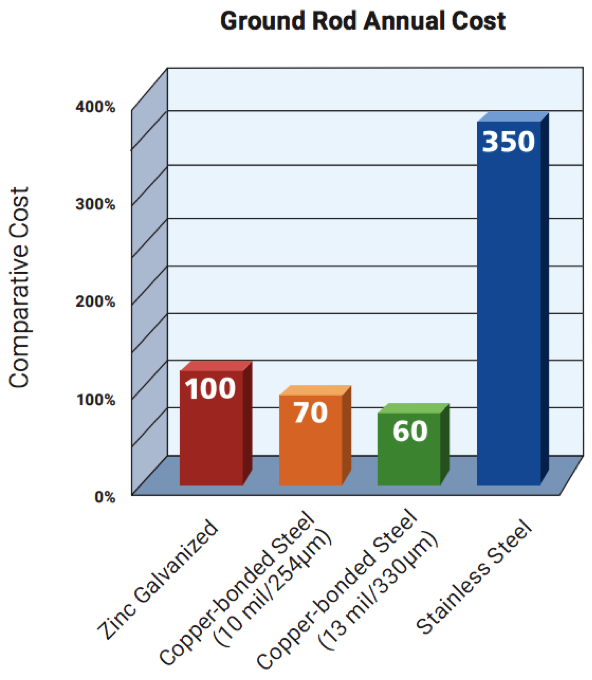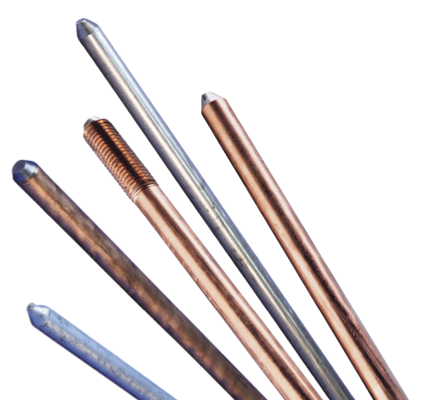 The purpose of a grounding system is to protect people, structures and equipment, and to ensure maximum safety from electrical system faults and lightning. A vital piece of the system is the ground electrode. The overall system’s reliability is dependent on this component. When using a ground rod for the ground electrode, the general performance or conductivity of available materials is minimal, but the service life of each material can vary by decades. In this post, we consider the 2 most important factors to weigh when selecting ground rod material.
The purpose of a grounding system is to protect people, structures and equipment, and to ensure maximum safety from electrical system faults and lightning. A vital piece of the system is the ground electrode. The overall system’s reliability is dependent on this component. When using a ground rod for the ground electrode, the general performance or conductivity of available materials is minimal, but the service life of each material can vary by decades. In this post, we consider the 2 most important factors to weigh when selecting ground rod material.
Factors to Consider in Grounding System Design
Consider the relationship between expected service life and cost in order to receive the best value from your ground rod. Below, we uncover the top two most important factors to consider before selecting a ground rod material.
1) Corrosion Resistance and Longevity
The expected service life should be the first— and most important— factor considered when selecting ground rods for a grounding system.
A ground rod’s resistance to corrosion is directly related to service life and overall system effectiveness— the quicker a ground rod corrodes, the shorter the service life and overall cost will be. Because below-grade products are exposed to significant corrosion threats, the service life between two materials can vary by years or decades. The resistance of a ground rod will significantly increase when corroded and can result in a catastrophic loss of ground over time.
2) Cost
Cost generally comes into play when contractors are attempting to cut costs by using a cheaper material, or balancing cost and corrosion resistance between materials like solid copper and stainless steel. When a grounding rod specification does not reference a specific brand, product or material, a contractor may choose the cheapest allowable ground rod. However, to maximize value and produce the safest, most reliable system for users, that may not be enough.
The upfront cost of one ground rod material should not be compared directly to another material. Rather, the lifecycle value of two materials should be compared. If one rod is $20 and another costs $30, but the cheaper rod will only last one-quarter as long as the other, the more expensive rod is clearly the more cost-effective choice.
National Electrical Grounding Research Project
To appropriately balance service life and cost when comparing ground rod materials, we can point to established studies from reputable third-party organizations for proof.
In 1996, the Fire Protection Research Foundation established the National Electrical Grounding Research Project (NEGRP), which studied the long-term performance of 18 different grounding electrodes in diverse geographical locations and soil types. It is the most extensive study on corrosion involving copper and galvanized material since a National Bureau of Standards study from 1910-1955.
Comparing the Service Life and Cost of Common Ground Rod Materials
Common ground rod material selection is based on the corrosion resistance of the rod, balanced with the longevity of the system. Galvanized steel, copper-bonded steel and stainless steel are the most common materials considered for grounding systems in most parts of the world.
Galvanized steel rods are often the go-to material because they are cheap, allowed by the NEC and UL listed. However, in the NEGRP study referenced above, it’s been uncovered that galvanized rods are an inferior material choice in terms of service life longevity. Also note that choosing a material based solely on its upfront cost does a disservice to the grounding system’s users and their safety, and will likely cost more in the long term.
Copper-bonded ground rods are a major step up in terms of corrosion resistance. The NEGRP found that copper-bonded ground rods last an average of 40 years in most soil types, compared to 15 for galvanized rods. This is a larger return compared to galvanized rods for a marginal initial cost increase.
For certain situations, stainless steel ground rods may be specified. According to the NEGRP, these ground rods offer a service life of around 50 years. In highly corrosive environments—such as at industrial plants or salty environments (e.g. ocean beaches)—stainless steel outlasts copper-bonded ground rods.

The chart above articulates a clear gap in service life for zinc galvanized ground rods when compared to its alternatives.
To clearly evaluate the value of each material, we can compare each material in terms of annual cost. If we now know zinc galvanized rods may need to be replaced twice before a copper-bonded or stainless steel rod does once, how does that translate into cost?

From a value perspective, stainless steel is the clear loser, explaining why it is only specified when absolutely necessary due to its high initial cost.
When comparing galvanized and copper-bonded ground rods, both copper-bonded products offer an annual cost advantage.
Dive Deeper on Grounding Systems
Now that you know The Pros and Cons of 4 Common Ground Rod Materials and the 2 Most Important Factors to Weigh When Selecting Ground Rod Material, take the next steps and read the:
3 Reasons Engineers Should Choose Copper-Bonded Ground Rods
Download the nVent ERICO Grounding, Bonding and nVent ERICO Cadweld Solutions Guide for an overview of facility electrical protection and where grounding fits in.
nVent ERICO has the ground rod solution that you can depend on. Download the flyer.
Image credit: Pixabay
